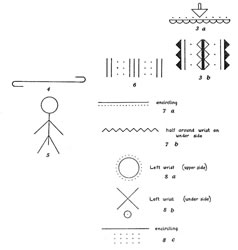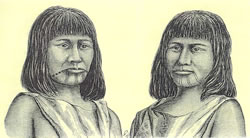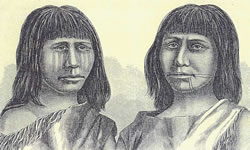Marks of Transformation:
Tribal Tattooing in California and the American Southwest
Article © 2010 Lars Krutak
The “Roasting” of Girls
Certain restrictions were placed on the girls during the course of the ceremony and for some time afterward. They were required in the first place, as already noted, to stay in the pit with as little movement as possible, leaving it only for short periods of time. If they moved or were restless, it was thought that they would become nervous and discontented for the rest of their lifetimes. Once every day, they were taken out of the pit and carefully wrapped in blankets. Then, the pit was relined with hot rocks and filled with fresh brush. During this period and for as long as possible afterward, the girls abstained from meat and salt. They were given, however, sage seed mush and drinking water. They were not supposed to look at people, especially men. They were carefully warned not to touch their hair with their hands. If they did so the elders told them it would fall out. For this reason each girl was provided with two “scratchers” of shell or of two sticks of wood.
| The girls were placed in the pit usually in the afternoon towards sunset. When they were comfortably situated, the female elders of the village gathered around them, each woman holding a branch of white sage. At a signal they waved these branches up and down. Meanwhile two of the older women chanted:
“Cover, cover; brush fine, eu!”
This song was repeated for quite some time. Then the branches of the sage were dipped in water and the girls were sprinkled. The same two woman sang:
“Sprink-sprink-sprinkle; ragweed sprinkle, sage brush, sprinkle.”
When the sun was low on the horizon, all of the women joined hands in a circle about the pit. Then they danced around in a line from left to right. Each woman held her arms outwards from her sides and raised first one hand and then the other to the music. The men of the village entered and sang the following song that referred to the sun as the women danced:
“low down, he is flying; low down, he is flying, eu!”
When the sun had set, the dancers circled in the opposite direction (that is, contrary to the course of the sun), and then the men chanted:
“circle the other way; circle the other way, eu!”
Such dances and other songs continued all night. And when the sun rose the next morning, the women sang:
“Sunrise, I menstruate; sunrise, I menstruate; red, eu!” |
 |
Northeastern & Western Yavapai. Only women wore tattoos and they were marked after their first menses. Tattooists were women and they plied three or four bundled cactus thorns into the skin to create carbon-based tattoos on the arms, chins, and foreheads of their clients. Sometimes a human figure was tattooed on the wrist to induce conception.
Western Yavapaimen possessed facial tattoos that consisted of crosses or circles on each cheek, wavy or zigzagging lines on the forehead, and a row of dots down the nose. Sometimes they also wore the chin patterns of women, or other motifs on their wrists, calves, or chests [Fig].
According to the old sources, men tattooed for ornamental reasons and were marked in their youth by other men or women and observed a strict four to five day fast during the healing period. If this taboo was broken, it was believed that the tattoo punctures would never heal.
Tattooing needles were manufactured by bundling three prickly pear cactus spines together. For pigment, mesquite charcoal was mixed with “deer brush” or mesquite leaves that had been previously pulverized on a rock and soaked in cold water. The liquid pigment was bluish in color. Expert tattooists were said to have been paid one buckskin for their epidermic work. |
On the second and following days of the ceremony, people from other neighboring villages came and joined the ritual.
  |
Drawings of Mohave Tattoo Markings, ca. 1900. “Mohave tatooing: charcoal & with needle; almost every individual has some; some among them make it; no official meaning of the designs known to those who are tatood; most common on forehead & chin, less so on forearm or from eye-corners & under lid…” |
|
|
|
However, it was on the second day of the roasting that an old woman began tattooing each of the girls with designs on their faces. She used a tool made of cactus thorn and her pigments were derived from powdered charcoal. Several sessions were required to complete the required designs which took the form of a stripe down each corner of the mouth and sometimes a third down the middle of the chin. Occasionally a small disc was placed between the eyes. It is said that if this tattooing was not performed, the girls “would turn into beetles when they died.”
The primary purpose of the ceremony was to promote the psychological well-being of the initiates in future life. And outside of the enforced taboos, elders informed early writers that it was an important time for chatting, laughing, and sleeping since time was “passed very cheerfully.” Obviously, another focus was to solidify the bonds of association between the girls and feelings of camaraderie that would come to last a lifetime. |
| Among the Maricopa of Arizona, the girl’s puberty rite aligns with those of the Luiseño and Diegueño of southern California in its emphasis concerning the girl’s future physiological well-being. At her first menses, a girl was secluded in a little lodge for eight days. During this period she sat all day long (but did not lie down), doing nothing, until late in the evening when she was allowed to sleep. She remained alone, so that she would have no one to talk with and thus would avoid growing garrulous. Unlike the Luiseño and Diegueño of California, Maricopa girls did not sing over the initiate at this point. One elder said: “We keep her just as quiet as we can. We do not make any noise around her.” Traditionally she was given very little food, only a gruel of mesquite beans. In particular, she must avoid meat and salt. She could not touch herself with her fingers: should she use them, her hair would fall out. Instead, a scratcher of arrowweed or mesquite was prepared by her parents. Her head was plastered all over every night, since she might forget and touch her hair. On the first four nights, this was mud mixed with pounded black mesquite bark; on the second four, mud alone. |
 |
Huchnom. Women with facial tattooing, ca. 1870. |
 |
| Huchnom. Women with facial tattooing, ca. 1870. |
Each morning, as she bathed, she washed this off, so that her hair would be dry before the sun rose. Her face up to the eyes was solidly painted a dark red. This was prepared by mixing red paint with the black liquid obtained from boiling mesquite bark. Her sole garment was a cotton skirt, newly made for the occasion. At the end of the period, it was thrown into the Gila River.
Next Page |
1
|
2 |
3 |
4 |
5 |
6 |
7 |
Museum photo gallery of the images
on this page may be seen here. |




